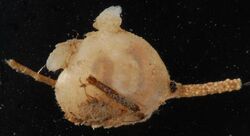Biology:Molgula manhattensis
| Molgula manhattensis | |
|---|---|

| |
| Scientific classification | |
| Domain: | Eukaryota |
| Kingdom: | Animalia |
| Phylum: | Chordata |
| Subphylum: | Tunicata |
| Class: | Ascidiacea |
| Order: | Stolidobranchia |
| Family: | Molgulidae |
| Genus: | Molgula |
| Species: | M. manhattensis
|
| Binomial name | |
| Molgula manhattensis (De Kay, 1843)
| |
Molgula manhattensis, commonly known as "sea grapes", is a species of ascidian commonly found along the East Coast and Gulf Coast region of the United States. Although it is native to this region, it has been introduced to other areas of Europe, Australia, and the West Coast.[1]
Description
Molgula manhattensis is small, spherical, brownish-grey in color, somewhat translucent, and feels soft and rubbery to the touch. Like other ascidians, they have two siphons (incurrent and excurrent), through which they draw water for ventilation and filter-feeding, and also for releasing their gametes. They are hermaphroditic, and release sperm and eggs into the water for external fertilization, unlike some other species of Molgula which may be viviparous (e.g. M. citrina).[2][3] The tunic is covered with many little fibrils.[4]
Habitat
Molgula manhattensis can live from the intertidal zone to a depth of 300 feet. They can attach to solid organisms or even rocks, pilings, buoys, or sand.[2] The sea squirts can also live in a temperature range of about 50 °F to about 80 °F. They can live in water with a salinity of 33.270 to 36.231 PSS, with oxygen concentrations between 3.960 and 6.328 mL/L.[3]
History
Mogula manhattensis is native to the East Coast of the United States and to waters around Europe. It is also found on the West Coast of the United States and to parts of Asia. Adults can live off of almost anything making them very good survivors in bodies of water though they prefer protected waters. The larvae can only live for a few days unless it attaches to a hard surface (similar to oysters and mussels).[2]
References
- ↑ "Invasive Species Tunicate Response in the Puget Sound Region: 2007-2009 Biennial Report". https://wdfw.wa.gov/publications/00106.
- ↑ 2.0 2.1 2.2 "Sea grape tunicate (Molgula manhattensis) - Aquatic Invasive Species | Washington Department of Fish & Wildlife". http://wdfw.wa.gov/ais/molgula_manhattensis/.
- ↑ 3.0 3.1 "Sea Grape - Molgula manhattensis - Details - Encyclopedia of Life". http://www.eol.org/pages/514053/details.
- ↑ "Connecticut Sea Grant | UConn". http://seagrant.uconn.edu/whatwedo/ais/listour.php.
Wikidata ☰ Q4923874 entry
 |

